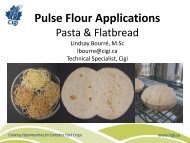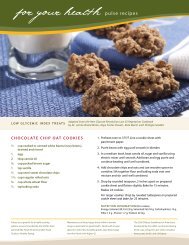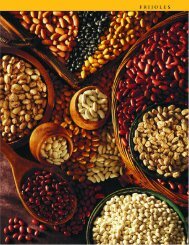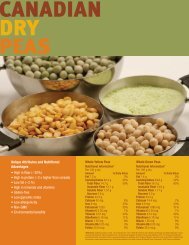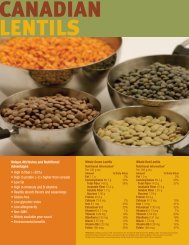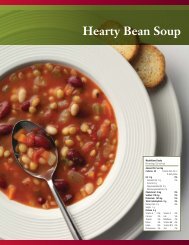Large Scale Recipe Manual - Pulse Canada
Large Scale Recipe Manual - Pulse Canada
Large Scale Recipe Manual - Pulse Canada
Create successful ePaper yourself
Turn your PDF publications into a flip-book with our unique Google optimized e-Paper software.
Storing and Cooking<br />
<strong>Pulse</strong>s<br />
Dry pulses will keep for years if stored in tightly-covered<br />
containers in a cool, dark, dry place. However, it is best<br />
to use pulses within a year of purchasing. The longer<br />
a pulse is stored, the drier it becomes, which increases<br />
the cooking time required.<br />
Canned pulses are very convenient as they are ready-touse.<br />
Always rinse and drain canned pulses before using.<br />
This simple step reduces the sodium content of canned<br />
pulses by more than 40%. 1 Canned pulses store well in<br />
cool, dry places. They may be stored for up to one year.<br />
1<br />
Duyff RL, Mount JR, Jones JB. Sodium reduction in canned beans after draining,<br />
rinsing. Journal of Culinary Science & Technology 2011;9(2):106-12.<br />
Soaking Tips and Methods<br />
• Dry beans, whole peas and chickpeas must be soaked<br />
before cooking.<br />
• Dry lentils and split peas do not need to be soaked, but<br />
should be rinsed before cooking.<br />
For every 1 cup (250 mL) of pulses, soak with 3 cups (750 mL)<br />
water. Whole peas can be soaked for 1-2 hours. Beans and<br />
whole chickpeas require longer soaking than whole peas<br />
(e.g. min. 4 hours, or preferably soak for 8 hours or overnight).<br />
Always discard the soaking water by putting pulses into<br />
a strainer and rinsing them well. This washes away the<br />
carbohydrates and sugars that cause gas.<br />
1<br />
Open a can of beans,<br />
pour the contents into<br />
a colander and drain for<br />
two minutes.<br />
SOAKING METHOD<br />
FOR DRY PULSES<br />
Long, cold soak or overnight<br />
INSTRUCTIONS<br />
• Let stand 12 hours or overnight<br />
in refrigerator<br />
Quick soak<br />
2<br />
Rinse the beans under<br />
tap water for at least<br />
10 seconds.<br />
• Bring pulses and water to boil<br />
in a saucepan<br />
• Boil gently for 2 minutes<br />
• Remove from heat, cover,<br />
and let stand for 1 hour<br />
Microwave soak<br />
3<br />
Allow beans to drain for<br />
two more minutes.<br />
• Combine pulses and water<br />
in microwavable dish<br />
• Cover and microwave on high<br />
for 10-15 minutes<br />
• Let stand for 1 hour<br />
Following these directions can further decrease the sodium content of the recipes included in this manual.<br />
Baking soda<br />
Some recipes call for baking soda (sodium bicarbonate) to shorten the<br />
cooking process, especially if using hard water. Baking soda increases<br />
the absorption of water, but it also destroys thiamin, an important B<br />
vitamin found in pulses. Baking soda may also make the texture of<br />
pulses too soft, an undesired side effect. Therefore, using baking soda<br />
to aid in cooking pulses is not recommended. If hard water is your<br />
only choice and you need to add baking soda, limit the amount to<br />
1/8 teaspoon per 2 cups (0.5 ml per 500 ml) water.<br />
Page 9




